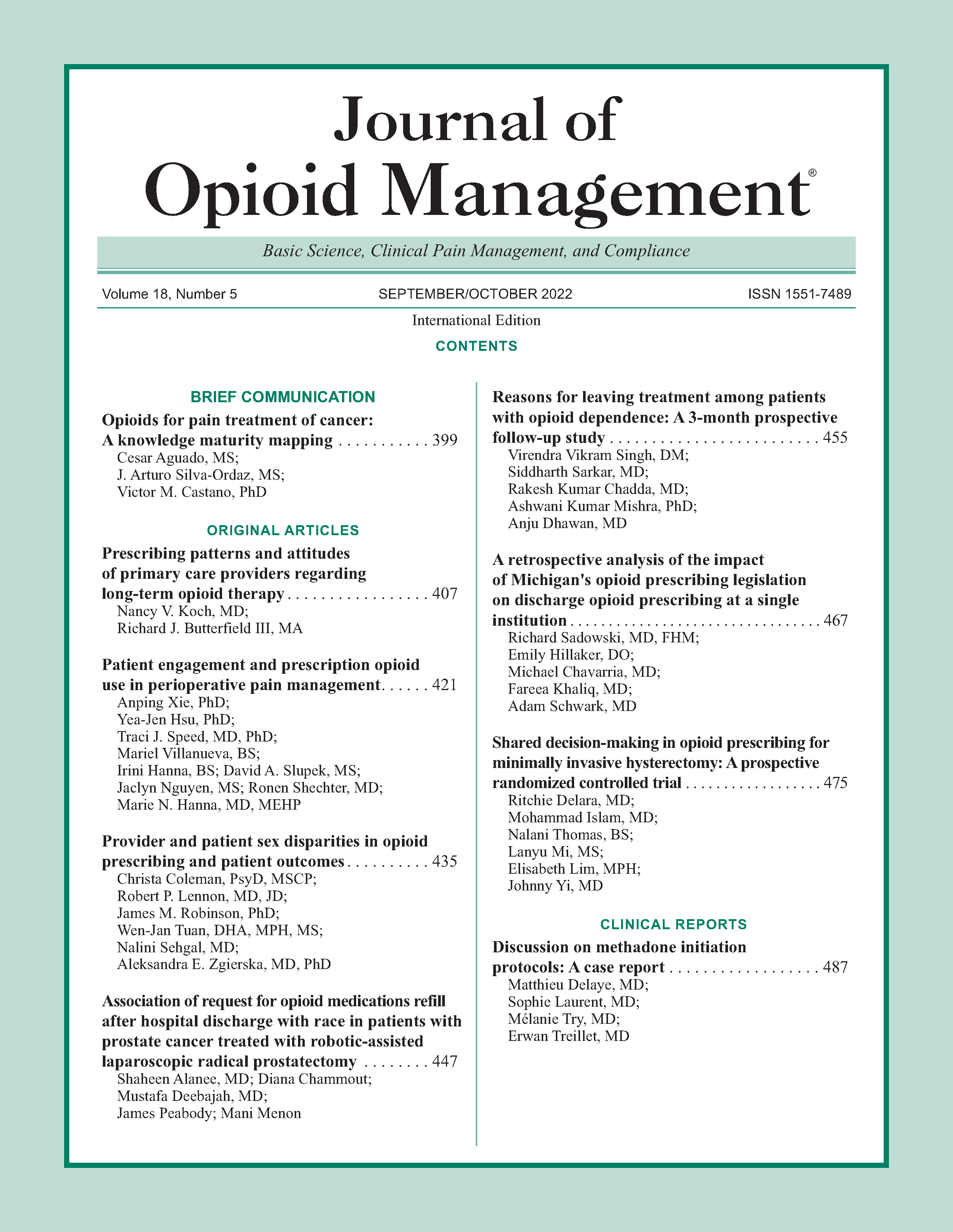Prescribing patterns and attitudes of primary care providers regarding long-term opioid therapy
DOI:
https://doi.org/10.5055/jom.2022.0735Keywords:
chronic pain, drug abuse, opioids, pain managementAbstract
Objective: To assess prescribing and referral patterns and attitudes of primary care providers treating patients receiving long-term opioid therapy (LOT) according to recent guidelines.
Design, setting, and participants: An anonymous 25-question survey was distributed to all primary care providers at Mayo Clinic in Arizona (from April 30 through May 22, 2020).
Main outcome measures: Knowledge and comfort with LOT guidelines, prescribing patterns, referral patterns to behavioral and pain specialties, patients’ concomitant substance use, and response variability by provider sex and specialty.
Results: Most of the 31 survey respondents were familiar with LOT guidelines and were comfortable in prescribing opioids; 36 percent reported no increase in prescribing safety. Patient education on naloxone was infrequent. Access affected referral to behavioral and addiction specialties; 87.1 percent referred patients to pain medicine specialists despite reporting little long-term improvement in symptoms. For a significantly larger proportion of internal medicine and women's health (IM/WH) providers, compared with family medicine (FM) providers, Patient Health Questionnaire 9 and Generalized Anxiety Disorder 7-item scale scores were the reasons for behavioral health referral. Many providers prescribed additional substances. More female providers reported that patients used gabapentin concomitantly (p = .03). More FM providers than IM/WH providers typically referred patients receiving LOT to addiction specialists (p = .02). Most expressed a need for a multispecialty LOT clinic, and 83.9 percent supported buprenorphine prescribing.
Conclusions: Despite familiarity with LOT guidelines, many providers felt that patient safety and prescribing diligence have not improved. Patient education on naloxone treatment is needed, and access to behavioral specialists is a barrier to referrals.
References
Khodaee M, Deffenbacher B: A look at the burden of opioid management in primary care. J Fam Pract. 2016; 65(12): E1-E6.
Dowell D, Haegerich T, Chou R: CDC guideline for prescribing opioids for chronic pain—United States, 2016. MMWR Recomm Rep. 2016; 65(No. RR-1): 1-49. DOI: 10.15585/mmwr.rr6501e1.
Arizona Department of Health Services: 2018 Arizona opioid prescribing guidelines. Updated December 2019. Available at https://azdhs.gov/documents/audiences/clinicians/clinicalguidelines-recommendations/prescribing-guidelines/az-opioidprescribing-guidelines.pdf. Accessed October 26, 2020.
Mayo Clinic: Mayo clinic guidelines for chronic opioid prescribing. Available at https://askmayoexpert.mayoclinic.org/document/guidelines-for-chronic-opioid-prescribing/doc-20346160?request_lang=en. Accessed October 14, 2020.
Jordan MR: Naloxone. StatPearls, 2020. Available at https://www.ncbi.nlm.nih.gov/books/NBK441910/. Accessed May 2, 2022.
Manchikanti L, Kaye AM, Knezevic NN, et al.: Responsible, safe, and effective prescription of opioids for chronic non-cancer pain: American society of interventional pain physicians (ASIPP) guidelines. Pain Phys. 2017; 2(2S): S3-S92.
Glei DA, Weinstein M: Mental health, pain, and risk of drug misuse: A nationwide cohort study. Addict Behav. 2020; 109: 106467. DOI: 10.1016/j.addbeh.2020.106467.
Sehgal N, Manchikanti L, Smith HS: Prescription opioid abuse in chronic pain: A review of opioid abuse predictors and strategies to curb opioid abuse. Pain Phys. 2012; 15(3 Suppl.): S67-S92.
Elrashidi MY, Philpot LM, Ramar P, et al.: Depression and anxiety among patients on chronic opioid therapy. Health Serv Res Manag Epidemiol. 2018; 5: 233339281877124. DOI:10.1177/2333392818771243.
Zedler B, Xie L, Wang L, et al.: Risk factors for serious prescription opioid-related toxicity or overdose among veterans health administration patients. Pain Med. 2014; 15(11): 1911-1929. DOI: 10.1111/pme.12480.
American Society of Addiction Medicine: The ASAM: National practice guideline for the use of medications in the treatment of addiction involving opioid use. 2015.
American Academy of Pain Medicine: For the primary care provider: When to refer to a pain specialist. Available at https://painmed.org/about/position-statements/for-the-primary-care-providerwhen-to-refer-to-a-pain-specialist. Accessed October 14, 2020.
Huhn AS, Dunn KE: Why aren't physicians prescribing more buprenorphine? J Subst Abuse Treat. 2017; 78: 1-7. DOI: 10.1016/j.jsat.2017.04.005.
Li X, Shorter D, Kosten TR: Buprenorphine prescribing: To expand or not to expand. J Psychiatr Pract. 2016; 22(3): 183-192. DOI: 10.1097/PRA.0000000000000154.
DeFlavio JR, Rolin SA, Nordstrom BR, et al.: Analysis of barriers to adoption of buprenorphine maintenance therapy by family physicians. Rural Remote Health. 2015; 15: 3019.
Zoorob R, Kowalchuk A, Mejia de Grubb M: Buprenorphine therapy for opioid use disorder. Am Fam Physician. 2018; 97(5): 313-320.
Patwardhan A, Matika R, Gordon J, et al.: Exploring the role of chronic pain clinics: Potential for opioid reduction. Pain Phys. 2018; 1(6): E603-E610.
Macerollo AA, Mack DO, Oza R, et al.: Academic family medicine physicians’ confidence and comfort with opioid analgesic prescribing for patients with chronic nonmalignant pain. J Opioid Manag. 2014; 10(4): 255-261. DOI: 10.5055/jom.2014.0213.
Jamison RN, Sheehan KA, Scanlan E, et al.: Beliefs and attitudes about opioid prescribing and chronic pain management: Survey of primary care providers. J Opioid Manag. 2014; 10(6): 375-382. DOI: 10.5055/jom.2014.0234.
Published
How to Cite
Issue
Section
License
Copyright 2005-2025, Weston Medical Publishing, LLC and Journal of Opioid Management. All Rights Reserved.











